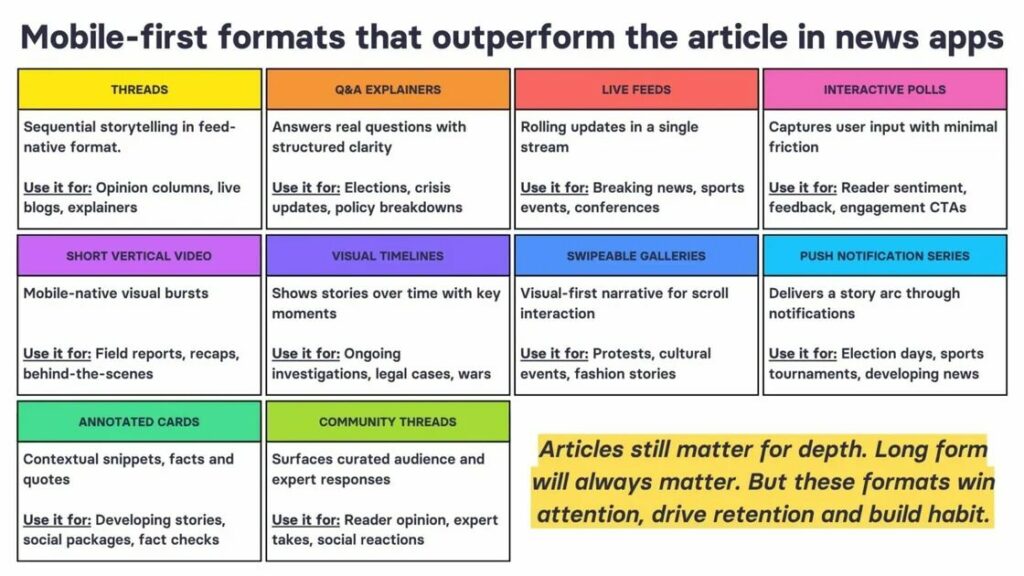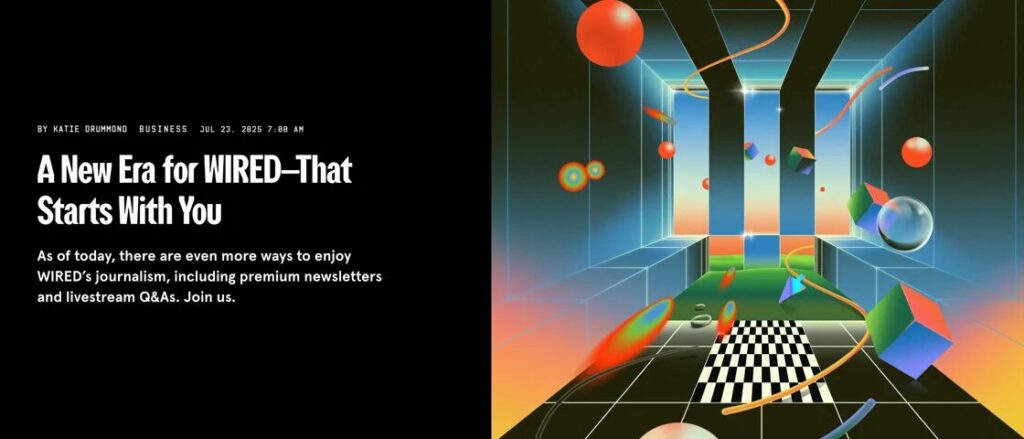

You're reading The Audiencers' newsletter #69 sent out on August 6th, 2025. To receive future newsletters straight to your inbox every two weeks, sign up here.
Happy August – I hope this newsletter finds you OOO, either on the beach, up a mountain or just generally very far from emails, Slack and LinkedIn!
If you’re working through the month like I am, you’re either swamped by the tasks of those who left you behind, or you’re basking in the joy of a quiet inbox. Either way, I’m glad to have your company (here in France the country literally shuts down for a month… there’s a lot we can learn from them, aside from just the wine & cheese 😅 )
🇺🇸 Side note: I’ve just booked my flights to go to the NPA Summit in Chicago in October, and will be passing through New York too! Any ideas on how we could make the most of this trip (I’m thinking a workshop/meet-up)? Help me make it happen! Reply to me via this email!
In today’s newsletter:
- When the article is no longer enough: formats that outperform the article on news app
- In case you missed it last year: 5 low-lift ways The Washington Post increased newsletter click-through rates
- WIRED launches a new subscription, showing a deliberate move towards community/relationship building
- Links to add to your summer reading list
When the article is no longer enough: formats that outperform the article on news app
Newsrooms still invest most of their time and energy into producing articles. It makes sense. The article is where the reporting lives. But the problem is not the journalism… It’s what the product assumes about how users will interact with it.
Users may open a news app several times a day, skim the top stories, engage with a visual, or skim the titles, and close the app without ever tapping on an article. This is not a sign of disinterest. It reflects how attention operates when time is short and options are endless.
Ultimately, format shapes experience. It organises information, guides comprehension and lowers the barrier to entry, helping the user know where they are and what comes next.
To reflect behavioral shifts in how users consume content, leading publishers are exploring a new set of formats – deliberate editorial structures designed to capture interest, reduce friction and guide users through complex stories in more natural ways.
> Heiko Scherer shares 10 mobile-first formats that have proven more effective than articles at the top of the engagement funnel – why it works, when to use it, and who is using it already

In case you missed it: 5 low-lift ways The Washington Post increased newsletter click-through rates
As shared by Kelly Poe at The Audiencers’ Workshop in New York last year, here are 5 low-lift ways the WP increases newsletter CTR
> Work with writers to use curiosity gaps.
A lot of audience engagement professionals are familiar with using curiosity gaps – the idea that you give away enough information to compel people to keep reading, but withholding enough that people will click – but the same concept applies in newsletters that are designed to drive people to your website.
> Draw from archives. This strategy is valuable for legacy news organizations, especially with recognizable brands or writers and evergreen content.
> Give habit-forming products a place in the newsletter, even if it’s not super relevant. For instance quizzes, such as WP’s “On the Record” quiz that they promote in most newsletters, even though it has little to do with most of their content.
“We produce it in the newsroom, so it is part of our journalism. In some of our newsletters that are designed to be more of an inbox experience, we’ve actually noticed sustained higher click-through rates since we’ve introduced the quiz.”
> Solicit 1-click feedback (and monitor it).
“When we built our new feedback system, we didn’t expect it to also raise click-through rates. Initially, we had a small text-only feedback request at the bottom of newsletters but wanted something easier for users. We created a two-click feedback form using Google Forms, allowing us to preload responses.
The form featured a smiley face to indicate liking the new design and space for additional feedback. Running this form daily in one newsletter, we received as much feedback in one month as we had in the previous six. This design significantly lowered the mental barrier for taking our survey.”
> Always be testing.
At The Washington Post, they’re almost always running some A/B test in the background. Kelly recommends ensuring you have a clear hypothesis, that you set a time period, that you measure results, see where else you can implement learnings and remember that the same strategy might not work the same in every newsletter.
Full article here (for The Audiencers’ subscribers)
WIRED launches a new subscription, showing a deliberate move towards community building
Ask Me Anything sessions, commenting, debates, and newsletters from individual journalists… WIRED’s new subscription offer is very clearly moving towards building durable relationships with reader (and rightly so!).

> Livestream Ask Me Anythings to connect subscribers directly with journalists. A proven community-building strategy by the likes of The Times, The Telegraph (read this article) & The Globe and Mail (check it out here)
> A new commenting experience: “join WIRED journalists and fellow subscribers in the comment sections of WIRED stories to discuss, debate, or ask and answer questions” – more interactive engagement for loyalty building
> Five exclusive, subscriber-only newsletters, each with writer at the forefront, helping to build relationships with readers (people connect with people, not brands!)

The TL;DR: belonging & community building needs to be at the center of your subscription model!
Links to add to your summer reading list:
- How The Atlantic keeps subscribers – without cutting prices
- How to turn registered members into subscribers
- AI and the subscriber funnel: How 3 newsrooms are using AI to grow, engage and retain audiences
- Ghost CMS has a new update that means it plugs directly into the next generation of social networks. Some are very impressed (“you can post, read and interact on platforms such as Threads, Bluesky, WordPress and Mastodon directly from Ghost”), others less so (“you should not distribute your core value—the things that make you worth subscribing to—to other places. Instead, you should focus on creating a form of publishing where people choose to come to you directly.”)
See you in two weeks for the next newsletter,
Madeleine


